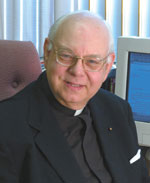Easter Sunday /
Msgr. Owen F. Campion
The Sunday Readings
 The Church celebrates the Easter Vigil late in the evening on Holy Saturday. These readings are those read during Masses on Easter Sunday itself.
The Church celebrates the Easter Vigil late in the evening on Holy Saturday. These readings are those read during Masses on Easter Sunday itself.
For its first reading on this extraordinary feast of Christian faith, the Church presents us with a passage from the Acts of the Apostles. Acts is, in effect, a continuation of St. Luke’s Gospel. Scholars say that this Gospel and Acts were the work of the same author. Beginning with the Ascension, Acts reports what life was like for the infant Church in Jerusalem, and then it recalls the initial spread of Christianity.
Important in the early chapters of Acts is a series of sermons delivered by St. Peter. He spoke for the Church as the leader, chosen by Christ himself, of the Apostles. In this reading, Peter briefly gives a synopsis of the life of Jesus. Sent by God, Jesus was crucified, the victim of human scheming. He rose after death. He commissioned the Apostles to continue the work of reconciling God and humanity. The Apostles learned from Jesus.
St. Paul’s Epistle to the Colossians, the second reading, places Christ at God’s right hand. Paul says that Christians already have “been raised” because they have taken Christ into their hearts (Col 3:1). Having given themselves to Jesus, they have died to earthly things and to earthly ideas. In the process, they have been drawn into the eternal life of the risen Lord.
St. John’s Gospel supplies the last reading. It goes into some detail about the Resurrection and its aftermath. The first figure mentioned in the story is Mary Magdalene. She was a beloved figure in early Christianity because she was an intense follower of Jesus. Indeed, according to John’s Gospel, she stood beneath the cross of Calvary rather than abandon the dying Lord. It was a risky act that might have construed her to be an accomplice in treason against the Roman Empire. Despite this danger—and the Romans were unforgiving—she remained.
She went to the tomb before daybreak. Finding it empty, she hurried to Peter and the disciple whom Jesus loved. (Tradition long has assumed this disciple to be St. John, although this Gospel passage never identifies the disciple by name.)
Peter and the disciple then rushed to the tomb themselves. They were overwhelmed. Grasping what exactly had happened at the tomb was not easy. Love and faith made the process easier. The beloved disciple saw that the tomb was empty. He believed that Jesus had risen.
Reflection
The Church joyfully tells us that the Lord lives. He rose from the dead. It is a proclamation of the greatest and central belief of the Church, namely that Jesus, the Son of God, overcame even death.
More than simply affirming once again the Church’s trust in the Resurrection of Christ, these readings call upon us to respond. Such was the message in Colossians, the second reading. Such is the important lesson in the references to Mary Magdalene, Peter and the disciple whom Jesus loved. They believed regardless of the costs, and in spite of the seeming impossibility of rising from the dead.
We too must believe. Such belief is so demanding. First, we must admit our limitations, confronting the fact that sin has weakened and blinded us. Then, we must submit ourselves to God, ready to be healed and strengthened. Hopefully, Lenten penances these past weeks have helped us in this process.
All this requires following the Lord. How do we know the Lord? Where do we meet the Lord? We hear Jesus in the testimony of Peter and the Apostles. We meet Jesus in the Church that they formed in Jerusalem, and then, beyond so long ago, the living, visible Church of God here and now. †
 The Church celebrates the Easter Vigil late in the evening on Holy Saturday. These readings are those read during Masses on Easter Sunday itself.
The Church celebrates the Easter Vigil late in the evening on Holy Saturday. These readings are those read during Masses on Easter Sunday itself.